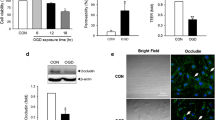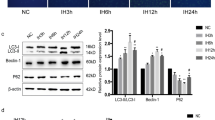Abstract
Using in vitro oxygen-glucose deprivation (OGD) model, we have previously demonstrated that 2-h OGD induces rapid, caveolin-1-mediated dissociation of claudin-5 from the cellular cytoskeletal framework and quick endothelial barrier disruption. In this study, we further investigated the fate of translocated claudin-5 and the mechanisms by which OGD promotes caveolin-1 translocation. Exposure of bEND3 cells to 4-h OGD, but not 2-h OGD plus 2-h reoxygenation, resulted in claudin-5 degradation. Inhibition of autophagy or the fusion of autophagosome with lysosome, but not proteasome, blocked OGD-induced claudin-5 degradation. Moreover, knockdown of caveolin-1 with siRNA blocked OGD-induced claudin-5 degradation. Western blot analysis showed a transient colocalization of caveolin-1, claudin-5, and LC3B in autolysosome or lipid raft fractions at 2-h OGD. Of note, inhibiting autophagosome and lysosome fusion sustained the colocalization of caveolin-1, claudin-5, and LC3B throughout the 4-h OGD exposure. EPR spin trapping showed increased nitric oxide (NO) generation in 2-h OGD-treated cells, and inhibiting NO with its scavenger C-PTIO or inducible nitric oxide synthase (iNOS) inhibitor 1400W prevented OGD-induced caveolin-1 translocation and claudin-5 degradation. Taken together, our data provide a novel mechanism underlying endothelial barrier disruption under prolonged ischemic conditions, in which NO promotes caveolin-1-mediated delivery of claudin-5 to the autophagosome for autophagy-lysosome-dependent degradation.








Similar content being viewed by others
References
Zehendner CM, Librizzi L, de Curtis M, Kuhlmann CR, Luhmann HJ (2011) Caspase-3 contributes to ZO-1 and Cl-5 tight-junction disruption in rapid anoxic neurovascular unit damage. PLoS One 6(2):e16760
Rosenberg GA (2012) Neurological diseases in relation to the blood-brain barrier. J Cereb Blood Flow Metab 32(7):1139–1151
Kaur C, Ling EA (2008) Blood brain barrier in hypoxic-ischemic conditions. Curr Neurovasc Res 5(1):71–81
Fontijn RD, Rohlena J, van Marle J, Pannekoek H, Horrevoets AJ (2006) Limited contribution of claudin-5-dependent tight junction strands to endothelial barrier function. Eur J Cell Biol 85(11):1131–1144
Nitta T, Hata M, Gotoh S, Seo Y, Sasaki H, Hashimoto N, Furuse M, Tsukita S (2003) Size-selective loosening of the blood-brain barrier in claudin-5-deficient mice. J Cell Biol 161(3):653–660
Morita K, Sasaki H, Furuse M, Tsukita S (1999) Endothelial claudin: claudin-5/TMVCF constitutes tight junction strands in endothelial cells. J Cell Biol 147(1):185–194
Jin R, Song Z, Yu S, Piazza A, Nanda A, Penninger JM, Granger DN, Li G (2011) Phosphatidylinositol-3-kinase gamma plays a central role in blood-brain barrier dysfunction in acute experimental stroke. Stroke 42(7):2033–2044
McColl BW, Rothwell NJ, Allan SM (2008) Systemic inflammation alters the kinetics of cerebrovascular tight junction disruption after experimental stroke in mice. J Neurosci 28(38):9451–9462
Yang Y, Estrada EY, Thompson JF, Liu W, Rosenberg GA (2007) Matrix metalloproteinase-mediated disruption of tight junction proteins in cerebral vessels is reversed by synthetic matrix metalloproteinase inhibitor in focal ischemia in rat. J Cereb Blood Flow Metab 27(4):697–709
Yang Y, Rosenberg GA (2011) Blood-brain barrier breakdown in acute and chronic cerebrovascular disease. Stroke 42(11):3323–3328
Giebel SJ, Menicucci G, McGuire PG, Das A (2005) Matrix metalloproteinases in early diabetic retinopathy and their role in alteration of the blood-retinal barrier. Lab Invest 85(5):597–607
Liu W, Hendren J, Qin XJ, Shen J, Liu KJ (2009) Normobaric hyperoxia attenuates early blood-brain barrier disruption by inhibiting MMP-9-mediated occludin degradation in focal cerebral ischemia. J Neurochem 108(3):811–820
Mishiro K, Ishiguro M, Suzuki Y, Tsuruma K, Shimazawa M, Hara H (2012) A broad-spectrum matrix metalloproteinase inhibitor prevents hemorrhagic complications induced by tissue plasminogen activator in mice. Neuroscience 205:39–48
Mandel I, Paperna T, Volkowich A, Merhav M, Glass-Marmor L, Miller A (2012) The ubiquitin-proteasome pathway regulates claudin 5 degradation. J Cell Biochem 113(7):2415–2423
Chen L, Zhang B, Toborek M (2012) Autophagy is involved in nanoalumina-induced cerebrovascular toxicity. Nanomedicine 9(2):212–221
Liu J, Jin X, Liu KJ, Liu W (2012) Matrix metalloproteinase-2-mediated occludin degradation and caveolin-1-mediated claudin-5 redistribution contribute to blood-brain barrier damage in early ischemic stroke stage. J Neurosci 32(9):3044–3057
Belayev L, Busto R, Zhao W, Ginsberg MD (1996) Quantitative evaluation of blood-brain barrier permeability following middle cerebral artery occlusion in rats. Brain Res 739(1–2):88–96
Rosenberg GA, Estrada EY, Dencoff JE (1998) Matrix metalloproteinases and TIMPs are associated with blood-brain barrier opening after reperfusion in rat brain. Stroke 29(10):2189–2195
Li XJ, Li S (2011) Proteasomal dysfunction in aging and Huntington disease. Neurobiol Dis 43(1):4–8
Mizushima N (2007) Autophagy: process and function. Genes Dev 21(22):2861–2873
Papandreou I, Lim AL, Laderoute K, Denko NC (2008) Hypoxia signals autophagy in tumor cells via AMPK activity, independent of HIF-1, BNIP3, and BNIP3L. Cell Death Differ 15(10):1572–1581
Ristic B, Bosnjak M, Arsikin K, Mircic A, Suzin-Zivkovic V, Bogdanovic A, Perovic V, Martinovic T et al (2014) Idarubicin induces mTOR-dependent cytotoxic autophagy in leukemic cells. Exp Cell Res 326(1):90–102
Lee SJ, Smith A, Guo L, Alastalo TP, Li M, Sawada H, Liu X, Chen ZH et al (2011) Autophagic protein LC3B confers resistance against hypoxia-induced pulmonary hypertension. Am J Respir Crit Care Med 183(5):649–658
Wu YT, Tan HL, Shui G, Bauvy C, Huang Q, Wenk MR, Ong CN, Codogno P et al (2010) Dual role of 3-methyladenine in modulation of autophagy via different temporal patterns of inhibition on class I and III phosphoinositide 3-kinase. J Biol Chem 285(14):10850–10861
Hansen TE, Johansen T (2011) Following autophagy step by step. BMC Biol 9:39
Yu L, McPhee CK, Zheng L, Mardones GA, Rong Y, Peng J, Mi N, Zhao Y et al (2010) Termination of autophagy and reformation of lysosomes regulated by mTOR. Nature 465(7300):942–946
Gonzalez E, Nagiel A, Lin AJ, Golan DE, Michel T (2004) Small interfering RNA-mediated down-regulation of caveolin-1 differentially modulates signaling pathways in endothelial cells. J Biol Chem 279(39):40659–40669
Santibanez JF, Blanco FJ, Garrido-Martin EM, Sanz-Rodriguez F, del Pozo MA, Bernabeu C (2008) Caveolin-1 interacts and cooperates with the transforming growth factor-beta type I receptor ALK1 in endothelial caveolae. Cardiovasc Res 77(4):791–799
Mukhopadhyay S, Lee J, Sehgal PB (2008) Depletion of the ATPase NSF from Golgi membranes with hypo-S-nitrosylation of vasorelevant proteins in endothelial cells exposed to monocrotaline pyrrole. Am J Physiol Heart Circ Physiol 295(5):H1943–H1955
Weaver J, Porasuphatana S, Tsai P, Budzichowski T, Rosen GM (2005) Spin trapping nitric oxide from neuronal nitric oxide synthase: a look at several iron-dithiocarbamate complexes. Free Radic Res 39(10):1027–1033
Bevers LM, Braam B, Post JA, van Zonneveld AJ, Rabelink TJ, Koomans HA, Verhaar MC, Joles JA (2006) Tetrahydrobiopterin, but not L-arginine, decreases NO synthase uncoupling in cells expressing high levels of endothelial NO synthase. Hypertension 47(1):87–94
Pan T, Kondo S, Le W, Jankovic J (2008) The role of autophagy-lysosome pathway in neurodegeneration associated with Parkinson’s disease. Brain 131(Pt 8):1969–1978
Chen L, Zhang B, Toborek M (2013) Autophagy is involved in nanoalumina-induced cerebrovascular toxicity. Nanomed Nanotechnol Biol Med 9(2):212–221
Fiucci G, Ravid D, Reich R, Liscovitch M (2002) Caveolin-1 inhibits anchorage-independent growth, anoikis and invasiveness in MCF-7 human breast cancer cells. Oncogene 21(15):2365–2375
Frank PG, Woodman SE, Park DS, Lisanti MP (2003) Caveolin, caveolae, and endothelial cell function. Arterioscler Thromb Vasc Biol 23(7):1161–1168
Gonzalez MI, Krizman-Genda E, Robinson MB (2007) Caveolin-1 regulates the delivery and endocytosis of the glutamate transporter, excitatory amino acid carrier 1. J Biol Chem 282(41):29855–29865
Hayer A, Stoeber M, Ritz D, Engel S, Meyer HH, Helenius A (2010) Caveolin-1 is ubiquitinated and targeted to intralumenal vesicles in endolysosomes for degradation. J Cell Biol 191(3):615–629
Mundy DI, Li WP, Luby-Phelps K, Anderson RG (2012) Caveolin targeting to late endosome/lysosomal membranes is induced by perturbations of lysosomal pH and cholesterol content. Mol Biol Cell 23(5):864–880
Ribeiro IP, Marques F, Caramelo F, Pereira J, Patricio M, Prazeres H, Ferrao J, Juliao MJ et al (2014) Genetic gains and losses in oral squamous cell carcinoma: impact on clinical management. Cell Oncol 37(1):29–39
Chanvorachote P, Nimmannit U, Lu Y, Talbott S, Jiang BH, Rojanasakul Y (2009) Nitric oxide regulates lung carcinoma cell anoikis through inhibition of ubiquitin-proteasomal degradation of caveolin-1. J Biol Chem 284(41):28476–28484
Egea J, Martin-de-Saavedra MD, Parada E, Romero A, Del Barrio L, Rosa AO, Garcia AG, Lopez MG (2012) Galantamine elicits neuroprotection by inhibiting iNOS, NADPH oxidase and ROS in hippocampal slices stressed with anoxia/reoxygenation. Neuropharmacology 62(2):1082–1090
Huang ZG, Xue D, Preston E, Karbalai H, Buchan AM (1999) Biphasic opening of the blood-brain barrier following transient focal ischemia: effects of hypothermia. Can J Neurol Sci 26(4):298–304
Kuroiwa T, Ting P, Martinez H, Klatzo I (1985) The biphasic opening of the blood-brain barrier to proteins following temporary middle cerebral artery occlusion. Acta Neuropathol (Berl) 68(2):122–129
Porasuphatana S, Weaver J, Budzichowski TA, Tsai P, Rosen GM (2001) Differential effect of buffer on the spin trapping of nitric oxide by iron chelates. Anal Biochem 298(1):50–56
Raines KW, Cao GL, Porsuphatana S, Tsai P, Rosen GM, Shapiro P (2004) Nitric oxide inhibition of ERK1/2 activity in cells expressing neuronal nitric-oxide synthase. J Biol Chem 279(6):3933–3940
Abedinpour P, Jergil B (2003) Isolation of a caveolae-enriched fraction from rat lung by affinity partitioning and sucrose gradient centrifugation. Anal Biochem 313(1):1–8
Acknowledgments
We thank the financial support from the National Natural Science Foundation of China, the National Institutes of Health, and Shenzhen Science and Technology Innovation Commission. Details of funding support are listed below.
Author information
Authors and Affiliations
Corresponding authors
Ethics declarations
Funding
This work was supported by grants from the National Natural Science Foundation of China (81371328), Shenzhen Science and Technology Innovation Commission (CXZZ20130516152706040 and ZDSY20140509173142601), and the National Institutes of Health (P20RR15636).
Rights and permissions
About this article
Cite this article
Liu, J., Weaver, J., Jin, X. et al. Nitric Oxide Interacts with Caveolin-1 to Facilitate Autophagy-Lysosome-Mediated Claudin-5 Degradation in Oxygen-Glucose Deprivation-Treated Endothelial Cells. Mol Neurobiol 53, 5935–5947 (2016). https://doi.org/10.1007/s12035-015-9504-8
Received:
Accepted:
Published:
Issue Date:
DOI: https://doi.org/10.1007/s12035-015-9504-8




